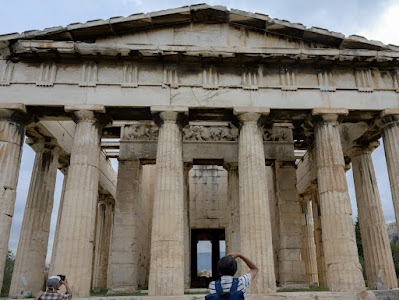Chicago day 1, still in the Loop
We moved away from the heart of the financial centre but were still in the downtown Loop of Chicago so that Michael could show us some more iconic buildings.
The Monadnock building consists of 2 parts, one built in 1891 and the other in 1893. The first part was designed by John Root who pushed the building to an incredible height of 16 storeys and designed large bay windows to let in light and air. At the base, masonry walls 16 feet deep were needed to support the structure.
The second part, built only 3 years later after Root's death, was designed by Holabird and Roche and used the new fangled steel framing to support the building and so the brickwork was far less extensive. The two parts were designed to match, it is only the depth of the brickwork which gives away the earlier building method. There was rather a nice hat store at the base of the building.
We then went on to see the Fisher Building (1896) and the Manhattan Building.The latter built in 1891 boasted a steel frame and a couple of new technological improvements. William Jenney, the architect set the building back on the 10th floor so that he could go higher. He also devised a system of hanging the masonry to the steel frame so that it could shift with the wind as the building did. The facade is a little grim but the engineering is spectacular.
We also saw the Old Colony Building (1894) where brick has been done away with all together. The grid like arrangement of the windows betrays the steel frame within and it is clad in limestone.
Next we were on to more contemporary architecture.
The Federal Centre was designed by Ludwig Mies Van de Rohe, an architect who very much made Chicago his city after he had fled Nazi Germany. In the 50's Chicago was very run down and Mayor Daly set about rejuvenating some of the city centre and involved Van de Rohe as his designer. The Federal centre is composed again of different parts and follows Van de Rohe's Bauhaus dictum of 'less is more'. On his rigid grid system every item lines up perfectly, even down to the light fittings, demonstrating his other dictum that 'God is in the details'. It was built between 1959 and 1975 with the work being continued by Gene Summers and Bruno Contetrato after Mies' death in 1969. The glass facade reflects the city around it.
There is a strange statue composed of parts of machinery and twisted metal, called the Town-Ho's Story, by Frank Stella in the lobby.
A little way away from the Federal Centre is the Courthouse Annexe, designed to hold prisoners until they came before the court. It was built in 1973 and designed by Harry Weese, very much with its purpose in mind.
Finally in this section, we looked at the newest building of the clutch, but you would be forgiven if you thought it was 19th century.
The Harold Washington Library Centre was built in 1989 after a highly publicised architectural competition, which was won by Hammond, Beeby and Babka. It recalls the buildings of Chicago's past with it's stone base and heavy red masonry.



















Comments
Post a Comment